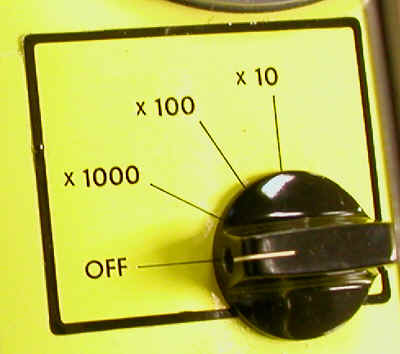CD V-700 Extended Range GM Detector (1963)


The range of the standard CD V-700 GM covers 0-50 mR/hr. For most applications following a nuclear attack this would be too low to be of much use. Primarily for this reason, the CD V-700 was often considered a training instrument.
In order to increase the instrument's usefulness, a special GM tube was produced in the early 1960s that would increase the 700's range by a factor of ten. This tube, the OCD-D-101, had a substantially smaller sensitive volume than the Model 6993 tube that it replaced.
The OCD-D-101 tube came with one or two "range position indicators." These were metal foil labels (2" x 2 1/2") with an adhesive on one side and the new range scale for the meter the other side (photo to right and below).


In the photo to the right, the business part of the OCD-D-101 tube can be seen inside the "cage." This would put the sensitive volume of the tube underneath the slots of the 700's probe, i.e., the beta window.
With the OCD-D-101 tube installed, the operating voltage is still the same, but the dead time and the background are reduced. Since the wall thicknesses for the OCD-D-101 and 6993 are both 30 mg/cm2, the intrinsic beta efficiencies will be similar for the standard and extended range CD V-700s. The difference, of course, is that the extended range CD V-700 now covers 0-500 mR/hr. Among other things, this increased range provides better overlap with the low range of the civil defense ion chambers (e.g., the CD V-710).
The main driver in the early 1960s for the creation of the OCD-D-101 GM tube was the realization that the levels of contamination in food would be significantly higher than what had been believed in the 1950s—the Department of Defense had been pretty secretive about this type of information. Although the CD V-700 was primarily for training, it did have one key "operational" function, at least initially: monitoring contamination in food using the 10-day standards. The extended range CD V-700 would be better able to monitor the higher levels that were now recognized to be possible.
The OCD-D-101 tubes were produced by two companies: Lionel Electronic Laboratories and Eon Corporation (Anton Electronics had been bought out by Lionel in the summer of 1960. The president of Anton, Nicholas Anton, resigned several months after the takeover, and a year later he started up a new company named EON which stands for electronic, optical and nuclear). Unluckily for Lionel and Eon, these tubes were expensive to produce and the companies were either losing money on the contracts or they were very close to losing money. At the time, one of the Lionel staff commented that he wasn't sure how long they could continue to produce the tubes and complained that every time they shipped one, it had a $10 bill wrapped around it.
The earliest reference I have found to the OCD-D-101 tube is from the 1962 annual report from the Office of Civil Defense. It indicates that Lionel Electronic Laboratories began development of "special-purpose Geiger-Mueller tubes" in July of 1961 and that this work was completed in FY 1962. The 1963 Radiological Monitoring Instruments and Equipment (for Civil Defense Operations): "A special Geiger tube, now under limited procurement, will shift the range of this instrument [the CD V-700] upwards by a factor of ten, that is to 0-5, 0-50, and 0-500 mr/hr."
The 1963 Annual Report of the Office of Civil Defense indicates that 100,000 of these "high range" Geiger tubes were ordered that year.
The following quote is from the EON Installation Instructions: "The OCD-D-101 GM tube is designed for use in the probe of the CDV-700 survey meter. It may be used in place of the existing 6993 type Geiger tube when it is desired to decrease the sensitivity of the CDV-700 survey meter. The gamma sensitivity of the D-101 tube is one-tenth that of the 6993 tube, therefore, the gamma sensitivity of each range on the CDV-700 is correspondingly decreased by a factor of ten. This extends each operating range of all CDV-700 models by a factor of ten."
In 1964, the Lionel Electronic Company began selling the OCD-D-101 to anyone who wanted to purchase one. A promotional letter sent by Lionel's General Sales Manager began as follows: "Gentlemen: DO YOU OWN A CDV 700? Regardless of the name of the manufacturer or model number, the enclosed information will be of interest to you. LIONEL announces the availability of the 301/OCD 101 GM Tube for commercial distribution. This tube was developed by the LIONEL ELECTRONIC LABORATORIES Engineering Department for the Office of Civil Defense in order to extend the range of all models of the CDV 700 Survey Meter to 500 mr/hr."
The last two references state that the purpose of the tube is to "extend" the range of the CD V-700. Hence, the common description of the survey meters using these tubes as "extended range" CD V-700s.
One specific application of the extended range CD V-700 would be to survey the aircraft used for aerial radiological monitoring. The 1966 Handbook for Aerial Radiological Monitors (Section 2.17) describes how the aircraft would be positioned in a relatively clean area so that "beta indications of contamination could be determined with the CD V-720 or a modified CD V-700 with a high-range tube [i.e., the OCD-D-101]."
References
- Marlow Stangler. Personal communication.
- Installation Instructions for the OCD-D-101 Geiger Mueller Tube in CDV-700 Low Range Portable Survey Instruments. Eon Corporation. No date. ca 1968.
- Specification Sheets for Lionel 114 and 301 GM Tubes. Lionel Electronic Laboratories. No date, but cover letter stamped 1964.
- Radiological Monitoring Instruments and Equipment (for Civil Defense Operations). Office of Civil Defense. 1963.
- Office of Civil Defense. Handbook for Aerial Radiological Monitors. FG-E-5.9.1, July 1966.
